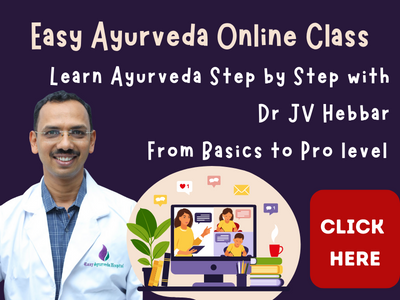Sushruta Samhita Sutrasthana Chapter 44 Virechanadravya Vikalpa Vijnaniya Adhyaya (Knowledge of Preparing Purgative Recipes)
The 44th chapter of Sutrasthana of Sushruta Samhita is named as Virechanadravya Vikalpa Vijnaniya Adhyaya. This chapter deals with Knowledge of Preparing Purgative Recipes.
अथातो विरेचनद्रव्यविकल्पविज्ञानीयमध्यायं व्याख्यास्यामः ॥१॥
यथोवाच भगवान् धन्वन्तरिः ॥२॥
We will now expound the chapter by name Virechana dravya Vikalpa Vijnaniya – knowledge of preparing recipes from purgative drugs, as revealed by the venerable Dhanvantari.
Table of Contents
Virechana Dravyah: Purgative drugs
अरुणाभं त्रिवृन्मूलं श्रेष्ठं मूलविरेचने ॥
प्रधानं तिल्वकस्त्वक्षु फलेष्वपि हरीतकी ॥३॥
तैलेष्वेरण्डजं तैलं स्वरसे कारवेल्लिका॥
सुधापयः पयःसूक्तमिति प्राधान्यसंग्रहः॥
तेषां विधानं वक्ष्यामि यथावदनुपूर्वशः ॥४॥
Below mentioned are the purgatives which are best in their respective categories –
– root of Trivrit which is slightly red in color is the best among root purgatives;
– bark of Tilvaka is the best among bark purgatives;
– Haritaki is the best among fruit purgatives;
– Eranda taila is the best among oils purgatives;
– fresh juice of Karavella among purgative juices and
– milky sap of Sudha among purgative saps (are the most important)
Now, their recipes and uses shall be described in succeeding order.
Mula Virechana: Purgative recipes from roots
Trivrit Kalpa: Recipes of trivrit
Shveta Trivrit – Operculina terepethum (Linn)
Shyama Trivrit – Ipomoea petaloids chois
Trivrit recipe for vata disorders
वैरेचनद्रव्यरसानुपीतं मूलं यहत्त्रैवृतमस्तत्त्रदोषम् ।
चूर्णीकृतं सैन्धवनागराढ्चमम्लैः पिबेन्मारुतरोगजुष्टः ॥५॥
Big roots of Trivrit which are unspoiled (not damaged by worms, fire etc) and soaked well in the juice or decoction of other purgative drugs are taken and pounded so as to prepare their fine powder.
This powder should be consumed with more quantity of Saindhava and Nagara; along with sour liquids by the person affected by diseases of vata origin.
Trivrit formulations for pitta and kapha disorders
इक्षोर्विकारैर्मधुरै रसैस्तत् पैत्ते गदे क्षीरयुतं पिबेच्च॥
गुडूच्यरिष्टत्रिफलारसेन सव्योषमूत्र कफजे पिबेत्तत् ॥६॥
In diseases of pitta origin, the same powder should be consumed along with the below mentioned –
– products of sugarcane – like sugar etc. or
– juice of drugs / herbs which are sweet in taste and
– with milk
In diseases of kapha origin, the same powder should be administered along with juice or decoction of the below mentioned, added with Vyosa and Gomutra –
– Guduci
– Arista
– Triphala
त्रिवर्णकत्र्यूषणयुक्तमेतद्रुडेन लिह्यादनवेन चूर्णम॥
प्रस्थे च तन्मूलरसस्य दत्वा तन्मूलकल्कं कुडवप्रमाणम् ॥७॥
कर्षोन्मिते सैन्धवनागरे च विपाच्य कल्कीकृतमेतसदद्यात॥
तत्कल्कभागाः समहौषधार्धः ससैन्धवो मूत्रयुतश्च पेयः ॥८॥
Powder of Trivrit should be mixed with powders of Trivarnakka (Trijata – twak, ela and patra), Tryusana (trikatu – pippali, maricha and shunti) and old jaggery and consumed (to cure kaphaja disorders).
Alternatively 1 kudava (160 grams) of paste of Trivrit should be soaked (boiled) in 1 prastha (640 grams) of decoction of the same roots (Trivrit) after adding 1 karsha (10 grams) each of Saindhava and Nagara. It should be consumed when the ingredients attain the form of a confection (become thick paste or jam like consistency).
Another form of using this is – one part of the paste of Trivrit should be mixed with half a portion of powder of shunthi and little quantity of saindhava and gomutra and consumed.
समास्त्रिवृन्नागरकाभयाः स्युर्भागार्धकं पूगफलं सुपक्वम् ॥
विडङ्गसारो मरिचं सदारु योगः ससिन्धूद्भवमूत्रयुक्तः ॥९॥
(विरेचनद्रव्यभवं तु चूर्णं रसेन तेषां भिषजा विमृद्य ॥
तन्मूलसिद्धेन च सर्पिषाऽऽक्तं सेव्यं तदाज्ये गुटिकीकृतं च ॥१०॥
गुडे च पाकाभिमुखे निधाय चूर्णीकृतं सम्यगिदं विपाच्य॥
शीतं त्रिजाताक्तमथो विमृद्य योगानुरुपा गुटीकाः प्रयोज्याः ॥११॥
Equal quantity of Trivrit, Sunti and Abhaya (2 tola each) along with half quantity each of (1 tola each) well ripened Puga phala, Vidanga, Marica and Devadaru should be powdered. In this 1 masha of Saindhava should be added and consumed with Gomutra.
Powder of Purgative drugs is soaked well in the juice (or decoction) of roots of the same purgative drugs. This should be mixed with ghee prepared with past roots of Trivrit and ground properly. Tablets should be prepared from this paste and should be consumed with ghee. Tablets of 3 masha should be prepared. These tablets / pills should be consumed in suitable doses and diseases.
The powder of purgative drugs (Trivrit etc) should be mixed in syrup of jaggery and cooked properly and cooled. When cooled, powder of Twak, Patra and Ela are added and grinded properly. Pills should be prepared from this. These pills shall be used to produce purgation in prescribed diseases.
वैरेकीयद्रव्यचूर्णस्य भागं सिद्धं सार्धं क्वाथभागैश्चतुर्भिः ॥
आमृद्रीयात् सर्पिषा तच्छ्र्तेन तत्क्वाथोष्मस्वेदितं सामितं च ।१२॥
पाकप्राप्ते फणिते चूर्णिते तत् क्षिप्तं पक्वं चावतार्य प्रयत्नात् ॥
शीतीभूता मोदका हृद्यगन्धाःकार्यस्त्वेते भक्ष्यकल्पाः समासात् ॥१३॥
Powder of Virechana Dravya i.e. purgative drug is taken in proportion to one and half part. It is boiled in four times the quantity of its own decoction (decoction prepared with the same virechana Dravya). Some quantity of ghee is added while cooking along with some quantity of Samita – flour of godhuma – wheat.
When the ingredients assume molasses like consistency, it is removed from the fire (cooking is stopped). After the contents get cooled and emit a pleasant smell, it is rolled into modaka i.e. big pills. These modakas are administered in suitable doses in suitable diseases.
रसेन तेषां परिभाव्य मुद्रान् यूषः ससिन्धूद्भवसर्पिरिष्टः ।
वैरेचनेऽन्यैरपि वैदलैः स्यादेवं विदध्याद्वमनौषधैश्च ॥१४॥
Mudga is boiled / triturated in the decoction of a purgative drug and its soup prepared. This soup is mixed with saindhava and ghee and used for purgation. Similarly, soup of other pulses may also be used along with decoction of purgative drugs (after boiling or triturating with them) for the purpose of purgation. The emetic recipes may also be prepared and used in a similar way.
भित्त्वा द्विधेक्षुं परिलिप्य कल्कैस्त्रिभण्डिजातैः प्रतिबध्यः रज्ज्वा।
पक्वं च सम्यक पुटपाकयुक्त्या खादेत्तुतं पित्तगदी सुशीतम् ॥१५॥
A piece of sugarcane is taken and split into two. Paste of Tribhandi – Sveta Trivrit is put inside the split. The split parts are now tied together with threads. This cane piece is then cooked by putapaka method, covered with mud plaster, and put into a hearth. When it gets properly cooked and becomes cool, it should be administered, mainly to those affected by diseases of pitta origin.
सिताजगन्धात्वक्क्षीरीविदारीत्रिवृतः समाः ॥
लिद्यान्मधुघृताभ्यां तु तृड्दाहज्वरशान्तये॥१६॥
Powder of equal quantity of the below mentioned ingredients should be added with honey and ghee and administered –
– Sita
– Ajagandha
– Tvakksiri
– Vidari
– Trivrit
Benefits – This recipe is beneficial to cure thirst, burning sensation and fever.
शर्कराक्षौद्रसंयुक्तं त्रिवृच्चूर्णावचुर्णितम् ॥
रेचनं सुकुमाराणां त्वक्पत्रमरिचांशकम् ॥१७॥
One part of fine powder of Trivrit should be added with one-fourth of powder of Twak, Patra and Marica and administered as purgative mixed with sugar and honey.
Benefits – it is a good recipe which can be used as a purgative for persons of tender constitution.
पचेल्लेहं सिताक्षौद्रपलार्धकुडवान्वितम् ॥
त्रिवृच्चूर्णयुतं शीतं पित्तघ्नं तद्विरेचम् ॥१८॥
Leha (confection) should be prepared with sharkara 1 pala, ksaudra (honey) ½ kudava and powder of Trivrit and should be consumed after it has been cooled. It is the best purgative. It also mitigates aggravated pitta and hence is beneficial for administration in pitta diseases.
त्रिवृच्छ्चामाक्षारशुण्ठीपिप्पलीर्मधुनाऽऽप्रुयात् ॥
सर्वश्लेष्मविकाराणां श्रेष्ठमेतद्विरेचनम् ॥१९॥
Below mentioned recipe of Trivrit, administered mixed in honey is a best purgative in all diseases produced by aggravated kapha –
Powders of:
– Trivrit,
– Syama (Vrddhadaraka according to Dalhana)
– Yavaksara,
– Sunthi, and
– Pippali
बीजाढ्चपथ्याकाश्मर्यधात्रीदाडिमकोलजान् ॥
तैलभृष्टान् रसानम्लफलैरावाप्य साधयेत् ॥२०॥
घनीभूतं त्रिसौगन्ध्यत्रिवृत्क्षौद्रसमन्वितम् ॥
लद्यमेतत्कफप्रायैः सुकुमारैर्विरेचनम् ॥२१॥
The below mentioned confection acts as a good purgative for those suffering from Kapha diseases and persons of tender constitution.
Preparation of decoction – Below mentioned fruits with prominent seeds inside them are fried in eranda taila i.e. castor oil and made into decoction –
– Pathya,
– Kasmarya,
– Dhatri,
– Dadima and
– Kola
Fruits of sour taste are cooked in this decoction.
When the decoction becomes thick, it is added with powder of Trisugandha and Trivrit.
Later, when the ingredients cool down, honey is added and mixed thoroughly.
The purgative confection recipe is ready for use.
नीलीतुल्यं त्वगेलं चतैस्त्रिवृसितोपला॥
चूर्णं संतर्पणं क्षौद्रफलाम्लं सन्निपातनुत् ॥२२॥
The combination of the below mentioned are consumed mixed with honey and juice of any fruit –
– Niliphala – one part,
– Tvak and Ela (together) – equal to Niliphala
– Powder of Trivrit and Sitophala – equal to the above three
This purgative recipe is nourishing in nature and also useful to mitigate sannipata dosha (simultaneous aggravation of all three doshas).
त्रिवृच्छ्चामासिताकृष्णात्रिफलामाक्षिकैः समैः ॥
मोदकाः सन्निपातोर्ध्वरक्तपित्तज्वरापहा ॥२३॥
The modaka – bolus prepared with equal parts of the below mentioned ingredients when administered would mitigate Sannipata Doshas –
– Trivrit,
– Syama,
– Sita,
– Krshna and
– Maksika (honey)
त्रिवृद्भागास्त्रयः प्रोक्तास्त्रिफला तत्समा तथा॥
क्षारकृष्णाविडङ्गानि संचूर्ण्य मधुसर्पिषा ॥२४॥
लिद्याद्रुडेन गुटिकाः कृत्वा वाऽप्यथ भक्षयेत् ॥
कफावातकृतान् गुल्मान् प्लीहोदरहलीमकान् ॥२५।
हन्त्यन्यानपि चाप्येतन्निरपायं विरेचनम् ॥
Powder should be prepared with the below mentioned ingredients –
– Trivrit – 3 parts
– Triphala (together) – 3 parts
– Ksara (Yavaksara) – 3 parts,
– Krsna – 3 parts and
– Vidanga – 3 parts
This powder should be mixed with honey and ghee and licked.
Alternatively, the powder is made into pills along with jaggery and consumed.
Benefits –
– This recipe is a safe purgative
– It cures abdominal tumor caused by Kapha-Vata
– Enlargement of spleen,
– Halimaka – advanced stage of jaundice (chlorosis)
– And many such diseases
चूर्णं श्यामा त्रिवृन्नीली कट्वी मुस्ता दुरालभा॥ २६॥
चव्येन्द्रबीजं त्रिफला सर्पिर्मांसरसाम्बुभिः॥
पीतं विरेचनं तद्धिरुक्षाणामपि शस्यते ॥२७॥
Powder of the below mentioned ingredients should be consumed along with ghee and meat soup –
– Syama,
– Trivrit,
– Nili,
– Katvi,
– Musta,
– Duralabha,
– Cavya,
– Indrabija and
– Triphala
Benefits –
– It produces easy purgation
– It is suited for persons having dryness of alimentary tract
वैरेचनिकनिः क्वाथभागाः शीतास्त्रनो मताः ॥
द्वौ फाणितस्य तच्चापि पुनरग्रावधिश्रयेत् ॥२८॥
तत् साधुसिद्धं विज्ञाय शीतं कृत्वा निधापयेत् ॥
कलशे कृतसंस्कारे विभज्यर्तू हिमाहिमौ ॥२९॥
मासादूर्ध्वं जातरसं मधुगन्धं वरासवम् ॥
पिबेदसावेव विधिः क्षारमूत्रासवेष्यपि॥३०॥
Decoction is prepared with three parts of purgative drugs like Trivrit etc.
The decoction is cooled.
To this, two parts of phanita – molasses are added.
The contents are boiled and the liquid is reduced to half the quantity and is allowed to cool.
It is now put into a pot smeared inside with honey. The mouth of the pot is sealed. Considering the cold or heat of the seasons, it is kept undisturbed for some days.
This fermented liquid is called Varasava. It should be taken out after one month, when the liquid has obtained a good taste and smell like honey. It shall be administered as a purgative.
Same is the procedure for preparing Asava from Ksara – alkalis and mutra – urine.
Sura Kalpana: Preparing beer
वैरेचनिकमूलानां क्वाथे माषान् सुभावितान् ॥
सुधौतांस्तत्कषायेण शालीनां चापि तण्डुलान् ॥३९॥
अवक्षुद्यैकतः पिण्डान् कृत्वा शुष्कान् सुचूर्णितान् ॥
शालितण्डुलचूर्णं च तत्कषायोष्मसाधितम् ॥३२॥
तस्य पिष्टस्य भागांस्त्रीन् किण्वभागविमिश्रितान् ॥
मण्डोदकार्थे क्वाथं च दद्यात्तत्सर्वमेकतः ॥३३॥
निदध्यात्कलशे तां तु सुरां जातरसां पिबेत् ॥
एष एष सुराकल्पो वमनेष्वपि कीर्तितः ॥३४॥
Masha should be soaked in the decoction of the root of purgative drugs slightly heated. Similarly rice which has been washed properly (and cleansed) should be soaked (triturated) in the same kashayas (decoctions prepared with purgative drugs). Both these masa (black gram) and rice should be pounded and made into a bolus. The powder of other types of rice should be cooked in the steam of the decoctions prepared with purgative drugs. This, one portion should be added with three portions of masa-tandula churna (powder of black gram and rice prepared above) and one part of kinva (yeast) mixed and stirred well. They are put into a pot and kept undisturbed for a few days after mixing the purgative decoctions so as to prepare sura. When it has attained good taste (good fermentation) or when sura (beer) is formed, it should be used for the purpose of purgation (as purgative medicine).
This method of preparing Sura (beer) can also be adopted for preparing emetic recipes.
Sauviraka Kalpana: Preparing another kind of beer
मूलानि त्रिवृदादीनां प्रथमस्य गणस्य च ॥
महतः पञ्च मूलस्य ऊर्वाशाङ्गे ष्टयोरपि ॥३५॥
सुधां हैमवतीं चैव त्रिफलातिविषे वचाम् ॥
संहृत्यैतानि भागौ द्वौ कारयेदेकमेतयोः ॥३६॥
कुर्यान्निःक्वाथमेकस्मिन्नेकस्मिंश्चूर्णमेव तु ।
क्षुण्णांस्तस्मिंस्तु निःक्वाथे भावयेद्वहुशो यवान् ॥३७॥
शुष्काणां मृदुभृष्टानां तेषां भागास्त्रयो मताः॥
चतुर्थं भागमावाप्य चुर्णानामत्र किर्तितम् ॥३८॥
प्रक्षिप्य कलशे सम्यक ततस्तं तदनत्तरम ॥
तेषामेव कषायेण शीतलेन सुयो जितम् ॥३९॥
पूर्ववत सन्निदध्यात्तु ज्ञेयं सौवीरकं हि तत् ॥
Below mentioned ingredients should be collected and made into two parts –
– Roots of purgative drugs like Trivrit etc.
– Drugs belonging to first gana – Vidarigandhadi group of herbs
– Five herbs comprising Mahat Pancha Mula
– Murva
– Sarngesta
– Sudha
– Haimavati
– Triphala
– Ativisa and
– Vaca
One part should be made into decoction. The other part is made into powder. Then dry yava (barley) should be soaked (triturated) in this (above prepared) decoction many times, dried and later fried slightly. Three parts of this powder of yava should be taken and mixed with one part of the powder (prepared above). The resultant powder should be put in a pot. Over this, the cold decoction (prepared with Trivrit etc as explained above) should be put (poured). The contents of the pot should be kept undisturbed for some days (for fermentation). The resultant preparation is called sauviraka. This sauviraka is used as a purgative recipe.
Tushodaka Kalpana: Preparing third kind of beer
पूर्वोक्तं वर्गमाहृत्य द्विधा कृत्वैकमेतयोः॥४०॥
भागं संक्षुद्य संसृज्यः यवैः स्थाल्यामधिश्रयेत् ॥
अजश्रृङ्ग्चाः कषायेण तमभ्यासिच्य साधयेत् ॥४१॥
सुसिद्धंश्चावतार्यैतानौषधिभ्यो विवेचयेत् ॥
विमृद्य सतुषान् सम्यक् ततस्तान् पूर्ववन्मितान् ॥४२॥
पूर्वोक्तौषधभागस्य चूर्णं दन्त्वा तु पूर्ववत् ॥॥।
तेनैव सह यूषेण कलशे पूर्ववत् क्षिपेत् ॥४३॥
ज्ञात्वा जातरसं चापि तत्तुषोदकमादिशेत ।
तुषाम्बुसौवीरकयोर्विधिरेष प्रकीर्तितः ॥४४॥
षड्रात्रात् सप्तरात्राद्वा ते च पेये प्रकीर्तिते ॥
The herbs which have been mentioned in the earlier verses (35-36) are collected. They are divided into two parts.
One part of the herbs shall be pounded with Yava – barley, made into a bundle and boiled in a big vessel along with Ajasrngi decoction.
Once it is well cooked, the bundle is removed from the decoction and opened. Yava is separated from other herbs and grinded well.
This powder is mixed with the powder of the remaining second part of the herbs mentioned earlier.
Later, this is put into the decoction prepared using the same herbs and barley, filled into a pot and kept as described earlier.
This liquid is taken out for usage after confirming that it has fermented well. This is known as Tusodaka.
Thus, the mode of preparing Tusambu – Tusodaka and Sauviraka have been described. The time required for the fermentation of these two is six or seven days following which they become suitable for drinking.
(For preparation of Sauviraka dehusked barley which is slightly fried is used. For Tusodaka, barley is used along with its husk and the barley is also not fried herein.)
वैरेचनेषु सर्वेषु त्रिवृन्मूलविधिः स्मृतः॥४५॥
Similar will be the procedure of preparing purgative recipes, for all virechana dravyas – purgative drugs, i.e. as described in case of Trivrit.
Danti Dravanti Kalpa: Recipes of Danti – Baliospermum monatum, Muell-Arg & Dravanti – Croton tiglium Linn
दन्तीद्रवन्त्येर्मूलानि विशेषान्मृत्कुशान्तरे ।
पिप्पलीक्षौद्रयुक्तानि स्विन्नान्युद्धत्य शोषयेत् ॥४६॥
ततस्त्रिवृद्विधानेन योजयेच्छलेष्मपित्तयोः ।
Roots of Danti and Dravanti should be taken. Along with Pippali and Honey, they are placed inside a bundle of Kusa grass. On this, a layer of mud is smeared. This bolus is now cooked by putting it inside a hearth. After it is properly cooked, it is taken out, dried and powdered. The method of usage is similar to that of Trivrit. It is highly beneficial in diseases caused by kapha and pitta.
तयोः कल्ककषायाभ्यां चक्रतैलं विपाचयेत् ॥४७॥
सर्पिश्च पक्वं वीसर्पकक्षादाहालजीर्जयेत् ॥
मेहगुल्मानिश्लेष्मविबन्धांस्तैलमेव च ॥४८॥
चतुः स्नेहं शकृच्छुक्रवातसम्सोधजा रुजः ॥
The paste and decoction of Danti and Dravanti is used to prepare Cakra Taila. Ghrta too is cooked and prepared in the same manner as of taila. It cures erysipelas / herpes, pustules arising in the axilla region, burning sensation and dermatitis.
The oil cooked with these herbs cures diabetes, abdominal tumors and diseases caused by aggravated vata and kapha and also constipation. Similarly, all four fats i.e. oil, ghee, muscle fat and bone marrow cooked with the same herbs cures diseases and pains caused by obstruction of feces, semen and flatus.
दन्तीद्रवन्तीमरिचकनकाह्वयवासकैः ॥४९॥
विश्वभेषजमृद्वीकाचित्रकैर्मूत्रभावितम् ॥
सप्ताहं सर्पिषा चूर्णं योजुमेतद्विरेचनम् ॥५०॥
जीर्णे संतर्पणं क्षौद्रं पित्तश्लेष्मरुजापहम् ॥
अजीर्णपार्श्वरुकपाण्डुप्लीहोदरनि बर्हणम् ॥५१॥
The below mentioned ingredients are kept soaked in gomutra – cow urine for seven days –
– Roots of Danti and Dravanti
– Marica
– Kanakahvya (Kankustha, Nagakesara),
– Yavasaka
– Visvabhesaja
– Mridvika and
– Chitraka
Afterwards, they are dried and made into powder.
This powder is mixed with ghee and used as a purgative.
Honey should be used as restorative after the recipe is digested. Alternatively, Laja sattu should be used with honey.
Benefits – This recipe is beneficial in treating –
– Diseases caused by aggravated pitta and kapha,
– Indigestion,
– Pain in flanks, anemia and
– Splenomegaly
गुडस्याष्टपले पथ्या विंशतिः स्युः पलः पलम् ॥
दन्तीचित्रकयोः कर्षो पिप्पलीत्रिवृतोर्दश॥५२॥
कृत्वैतान्मोदकानेकं दशमे दशमेऽहनि॥
ततः खादेदुष्णतोयसेवी निर्यन्त्रणास्त्विमे ॥५३॥
दोषघ्ना ग्रहणीण्डुरोगार्शः कुष्ठनाशनाः ॥
Below mentioned ingredients are powdered nicely and made into ten pills,
– Guda – jaggery (eight pala),
– Pathya – Terminalia chebula – twenty in number
– Danti – one pala
– Citraka – one pala
– Pippali – one karsa
– Trivrit – 1 karsa
One pill should be consumed on every tenth day. Following this, warm water should be consumed and the patient should also observe restraints like avoiding sunlight, severe breeze etc.
Benefits – This pill is beneficial in –
– Mitigating the doshas,
– Curing duodenal diseases, anemia, hemorrhoids and skin diseases
Trivrdastaka modaka
व्योषं त्रिजातकं मुस्ता विडङ्गामलके तथा॥५४॥
नवैतानि समांशानि त्रिवृदष्टगुणानि वै॥
श्लक्ष्णचूर्णीकृतानीह दन्तीभागद्वयं तथा॥५५॥
सर्वाणि चूर्णितानीह गालितानि विमिश्रयेत् ।
षड्भिश्च शर्कराभगैरीषत्सैन्धवमाक्षिकैः ॥५६॥
पिण्डितं भक्षायित्वा तु ततः शीताम्बु पाययेत् ॥
बस्तिरुक्तृडज्वरच्छर्दिशोषपाण्डुभ्रमापहम् ॥५७॥
निर्यन्त्रणणमिदं सर्वविषघ्नं तु विरेचनम् ॥
त्रिवृदष्टकसंज्ञोऽयं प्रशस्तः पित्तरोगिणाम् ॥५८॥
भक्ष्यः क्षीरानुपानो वा पित्तश्लेष्मातुरैर्नरैः॥
भक्ष्यरुपसधर्मत्वासाढ्चेष्वेव विधीयते ॥५९॥
Ingredients –
– Vyosa – Pippali, Marica and Shunti
– Trijataka – Twak, Ela and Patra
– Musta
– Vidanga
– Amalaka
All these nine drugs taken in equal quantities together form one part.
To this, eight parts of Trivrit and two parts of Danti are added. All are pounded together and their nice powder prepared. The powder is filtered through the cloth. This powder is now mixed with six parts of sugar, small quantities of Saindhava and Honey and made into pills.
The patient should drink cold water after consuming these pills and also should stay restrained.
Benefits – This recipe cures –
– Pain in the bladder,
– Thirst,
– Fever,
– Vomiting,
– Consumption,
– Anemia and
– Vertigo and
– All kinds of poisons
This purgative recipe is known as Trivrdastaka (modaka).
It is ideal for those suffering from pittaja diseases. People suffering from pittaja and kaphaja diseases can also take this recipe followed by drinking the milk. The recipe also shall be administered even to wealthy persons since it is similar to bhakshya (foods) in qualities.
Tvak Virechana: Recipes from purgative barks
Tilvaka Kalpa: Recipes of Tilvaka Symplocos racemosa Roxb
तिल्वकस्य त्वचं बाह्यामन्तर्वल्कविवर्जिताम् ॥
चूर्णयित्वा तु द्वौ भागौ तत्कषायेण गालयेत् ॥६०॥
तृतीयं भावितं तेन भागं शुष्कं तु भावितम् ॥
दशमूलीकषायेण त्रिवृद्वत्संप्रयोजयेत् ॥६१॥
विधानं त्वक्षु निर्दिष्टं
The outer bark of Tilvaka, devoid of its inner layer, is collected, dried well and made into powder and divided into three portions. Two portions are boiled with its own (Tilvaka) Kashaya. The remaining third portion of the powder is soaked in this Kashaya (triturated) and is later dried. Later this powder is triturated (soaked in) Dasamula decoction, dried and used for purgation just like Trivrit (recipe).
Phala Virechana: Recipes from purgative fruits
Haritaki kalpa: Recipes of Haritaki (Terminalia Chebula Retz)
फलानामथ वक्ष्यते ॥
हरीतक्याः फलं त्वस्थिविमुक्तं दोषवर्जितम् ॥६२॥
योज्यं त्रिवृद्विधानेन सर्वाधिनिबर्हणम् ॥
रसायनं परं मेध्यं दुष्टा न्तर्व्रणशोधनम् ॥६३॥
हरीतकी विडङ्गानि सैन्धवं नागरं त्रिवृत् ॥
मरिचानि च तत्सर्वं गोमूत्रेण विरेचनम् ॥६४॥
हरीतकी भद्रदारु कुष्ठं पूगफलं तथा।
सैन्धवं शृङ्गवेरं च गोगराभययोस्तथा॥६५॥
नीलिनीफलचूर्णं तु नागराभययोस्तथा |
लिह्याद्रुडेन सलिनं पश्चादुष्णं पिबेन्नरः ॥६६॥
पिप्पल्यादिकषायेण पिबेत्पिष्टां हरीतकीम् ॥
सैन्धवोपहितां सद्य एष योगो विरेचयेत् ॥६७॥
हरीतकी भक्ष्यमाणा नागरेण गुडेन वा ॥
सैन्धवोपहिता वाऽपि सातत्येनाग्रिदीपनि॥६८॥
वातानुलोमनी वृष्या चेन्द्रियाणां प्रसादनी॥
संतर्पणकृतान् रोगान् प्रायो हन्ति हरीतकी॥६९॥
Next, the (purgation) recipes prepared from fruits will be described.
Haritaki Phala – fruits of Terminalia chebula – whose seeds have been removed and which are devoid of blemishes should be used in a similar way as that of Trivrit. This Haritaki cures all diseases. It is the best rejuvenator, promotes intelligence and cleanses internal ulcers.
Nice powder prepared with the below mentioned ingredients when consumed with gomutra – cow urine, is a good purgative –
– Haritaki,
– Vidanga,
– Saindhava,
– Nagara,
– Trivrit and
– Marica
The powder of equal quantities of the below mentioned herbs should be consumed with gomutra – urine of cow for effective purgation –
– Haritaki
– Bhadradaru
– Kustha
– Pugaphala
– Saindhava
– Srngavera
Powder of the below mentioned ingredients when licked with guda – jaggery followed by drinking of hot water, acts as a good purgative –
– Nilini phala
– Nagara
– Abhaya
Paste of Haritaki is made. It is mixed in the decoction of Pippalyadi Gana group of herbs. To this, Saindhava Lavana – rock salt is added. This recipe produces instant purgation.
When Haritaki is consumed habitually along with one of the below mentioned, added with Saindhava, it produces immediate purgation –
– With Nagara
– With Guda or
– With Pippalyadi Gana group of herbs
When consumed with Nagara, Guda or Saindhava, Haritaki kindles agni – digestive fire.
Other benefits of Haritaki –
– Makes vata to move downwards,
– Is aphrodisiac
– Bestows keenness in the sense organs,
– Cures diseases caused by excessive nourishment
Triphala Kalpa: Recipes of Triphala
शीतमामलकं रुक्ष्यं पित्तमेदःकफापहम् ॥
विभीतकमनुष्णं तु कफपित्तनिबर्हणम् ॥७०॥
त्रीण्यप्यम्लकषायाणि सितिक्तमधुराणि च ॥
त्रिफला सर्वरोगघ्नी त्रिभागघृतमूर्च्छिता ॥७१॥
वयसः स्थापनं चापि कुर्यात् संततसेविता ॥
हरीतकीविधानेन फलान्येवं प्रयोजयेत् ॥७२॥
विरेचनानि सर्वाणि
Properties of Amalaka –
– Cold
– Dry – non-unctuous
– Mitigates pitta, kapha and medas
Properties of Bibhitaka –
– Cold in potency,
– Mitigates kapha and pitta
All three fruits of Triphala i.e. Haritaki, Bibhitaki and Amalaki are –
– Sour and astringent in taste – prominently
– Bitter and sweet – slightly
When consumed with three parts of ghee, Triphala cures all the diseases.
When it is habitually consumed it withholds ageing i.e. acts as anti-ageing medicine.
Use of all the other purgative fruits will be in the same manner as prescribed in case of Haritaki.
Chaturangula Kalpa: Recipe of Cassia fistula
विशेषाच्चतुरङ्गुलात् ।
फलं काले समुद्धत्य सिकतायां निधापयेत् ॥७३॥
सप्ताहमातये शुष्कमतो, मज्जानमुद्धरेत् ॥
तैलं ग्राह्यं जले पक्त्वा तिलवद्वा प्रपीड्च च ॥७४॥
तस्योपयोगो बालानां यावद्वर्षणि द्वादश ॥
लिह्यादेरण्डतैलेन कुष्ठत्रिटुकान्वितम् ॥७५॥
सुखोदकं चानुपिबेदेष योगो वोरेचयेत् ॥
Fruits of Chaturangula – Cassia fistula should be collected at appropriate time. The collected fruits should be kept buried for seven days inside sand. After seven days, the fruits should be removed and dried in sunlight. Its marrow (pulp – gummy material inside the fruit) is collected separately. Their oil is now extracted by boiling them in water. Alternatively, their oil is pressed as is done from tila – sesame.
This oil of Chaturangula can be used for children up to twelve years of age. This may also be licked by adults along with Eranda Taila – castor oil and powder of Kustha and Trikatu. Following this, they should drink warm water. These recipes easily produce purgation.
Taila Virechana: Recipes from purgative oils
एरण्डतैलं त्रिफलाक्वाथेन त्रिगुणेन तु ॥७६॥
युक्तं पीतं तथा क्षीररसाभ्यां तु विरेचयेत् ॥
बालवृद्धक्षतक्षीणसुकुमारेषु योजितम् ॥७७॥।
Eranda taila – castor oil can be used with one of the below mentioned to produce purgation –
– three times its quantity of Triphala Kashaya – decoction of Triphala or
– milk or
– meat soup
It may be administered in all the below mentioned persons –
– children
– aged persons
– wounded persons,
– emaciated ones
– those of tender constitution
Kshira Virechana: Recipes from purgative latex
Snuhi
फलानां विधिरुद्दिष्टः
क्षीराणं शृणु सुश्रुत ! ॥
विरेचनानां तीक्ष्णानां पयः सौधं परं मतम् ॥७८॥
अज्ञप्रयुक्तं तद्धन्ति विषवत् कर्मविभ्रमात ॥
विजानता प्रयुक्तं तु महान्तमपि संचयम ॥७९॥
भिनत्त्याश्वेव दोषाणां रोगान् हन्ति च दुस्तरान् ॥
Thus, the method of using purgative fruits.
Listen to the recipes prepared from latex (milky sap) dear Sushruta. Milky sap of Sudha / Snuhi – Euphorbia neriifolia is considered as the best. Just like the poison kills a person by improper usage, milky sap of Sudha kills the patient when administered by an ignorant physician. But when it is administered by a physician having thorough knowledge of Sudha, it quickly removes even great accumulation of doshas. It would also cure such diseases which have been declared as difficult to cure.
महत्याः पञ्चमूल्यास्तु बृहत्योश्चैकशः पृथक् ॥८०॥
कषायैः समभागं तु तदङ्गारेषु शोषितम् ।
अम्लादिभिं पूर्ववत्तु प्रयोज्यं कोलसंमितम् ॥८१॥
महावृक्षपयः पीतैर्यवागूस्तण्डुलैः कृता॥
पिता विरेचयत्याशु गुडेनोत्कारिका कृता ॥८२॥
लेहो वा साधितः सम्यक् स्नुहीक्षीरपयोघृतैः ॥
भावितास्तु स्नुहीक्षीरे पिप्पल्यो लवणान्विताः ॥८३॥
चूर्णं काम्पिल्लकं वाऽपि तत्पितं गुटिकीकृतम् ॥
Decoction of herbs included in Mahat Pancamula (five herbs) and two kinds of Brihati (two herbs) – seven herbs in total – is prepared. To this, milky sap of Snuhi – one part – is added. It is consumed in one kola (10 gm) dose. Following this, he should be made to drink sour liquids like Sura, Mastu, Kanjika etc to produce purgation.
Rice is kept soaked in milky sap of Snuhi. Later, it is removed and dried well. Using this rice, Yavagu – thick gruel is prepared and consumed. This recipe produces purgation.
Alternatively, Panaka – syrup – shall be prepared using guda – jaggery or confection prepared with Snuhi sap, milk and ghee may be used.
Pippali, Lavana – salt and dust of Kampillaka are kept soaked in Snuhi sap and later made into pills. When consumed, these pills produce purgation.
Saptala, Sankhini, Danti, Trivrit and Aragvadha
सप्तला शङ्खिनी दन्ती त्रिवृदारग्वधं गवाम् ॥८४॥
मुत्रेणाप्लाव्य सप्ताहं स्नुहीक्षीरे ततः परम् ॥
किर्णं तेनैव चूर्णेन माल्यं वस नमेव च ॥८५॥
आघ्रायावृत्य वा सम्यड्मृदुकोष्ठो विरिच्यते ॥
क्षीरत्वक्फलमूलानां विधानैः परिकीर्तितैः ॥
अवेक्ष्य सम्यग्रोगादीन यथावदुपयोजयेत् ॥८६॥
Powder of the below mentioned is soaked in urine of cow for seven days and dried –
– Saptala,
– Sankhini,
– Danti,
– Trivrit and
– Aragvadha
This powder is soaked in Snuhi sap for seven days and dried.
This fine powder is sprinkled on garlands of flowers or clothes. They are given to the patient for inhaling.
People having soft bowel movements will have purgation if inhalation is done repeatedly.
The physician should administer the purgative recipes prepared from latex, bark, fruits and roots of herbs described until now after carefully considering the nature of diseases.
Sresta Virechana yoga: Best purgative recipe
त्रिवृच्छाणमितास्तिस्रस्तिस्रश्च त्रिफलात्वचः॥
विडङ्गपिप्पलिक्षारशाणास्तिस्रश्च चुर्णिताः ॥८७॥
लिह्यात् सर्पिर्मधुभ्यां च मोदकं वा गुडेन वा॥
भक्षयोन्निष्परिहारमेत् च्छ्रेष्ठं विरेचनम् ॥८८॥
गुल्मं प्लीहोदरं कासं हलीमकमरोचकम् ॥
कफवातकृतांश्चान्यान् व्याधीनेतह्यपोहति ॥८९॥
Nice powder of the below mentioned is prepared –
– Trivrit – one Sana (750 mg),
– Bark of each of triphala (Haritaki, Bibhitaki and Amalaki) – three Sana each (2 ½ gm)
– Vidanga, Pippali, and Yavaksara together – three Sana (2 ½ gm)
This powder is given for licking along with ghee and honey.
Alternatively, the powder is made into pills using guda (jaggery) and consumed.
This recipe is the best purgative medicine.
Benefits –
It is free from any hazard and is safe purgative.
It cures –
– Abdominal tumors
– Splenomegaly
– Cough
– Chlorosis
– Loss of taste and
– Other diseases caused by aggravated kapha and vata
घृतेषु तैलेषु पयःसु चापि मद्येषु मुत्रेषु तथा रसेषु।
भक्ष्यान्नलेह्येषु च तेषु तेषु विरेचनान्यग्रमतिर्विदध्यात् ॥९०॥
A wise physician should administer Virechana Dravya – purgative recipes prepared from appropriate herbs along with –
– medicated ghee,
– oil
– milk
– wine
– urine and
– meat soup
Six formulations of drugs which are ‘light’ in successive order
क्षीरं रसः कल्कमथो कषायः श्रृतश्च शीतश्च तथैव चुर्णम् ।
कल्पाः षडेते खलु भेषजानां यथोत्तरं ते लघवः प्रदिष्टाः ॥९१॥
The six kinds of formulation of drugs which are described as light (easy for digestion) in their successive order are –
– fresh juice,
– paste,
– decoction,
– hot infusion,
– cold infusion and
– powder
इति श्रीसुश्रुतसंहितायां सूत्रस्थाने विरेचनद्रव्यविकल्पविज्ञानीये नाम चतुश्चत्वारिंशोऽध्यायः ॥४४॥।
Thus ends the Forty fourth chapter by name Virechana dravya Kalpa Vijnaniya in sutra Sthana of Susruta samhita.









